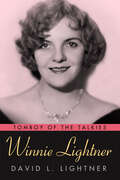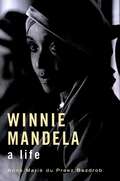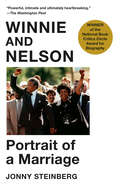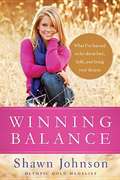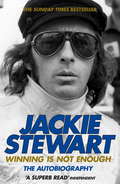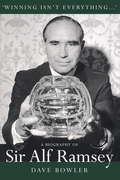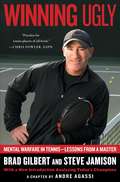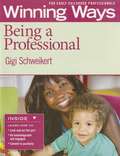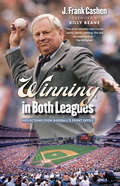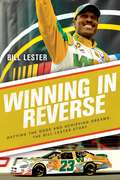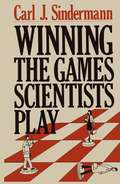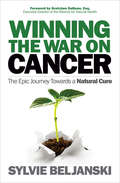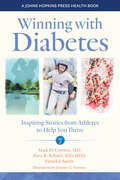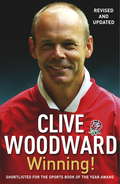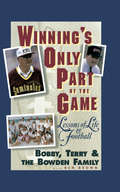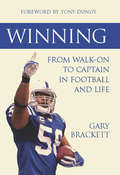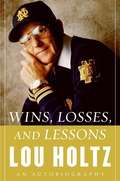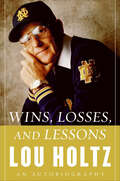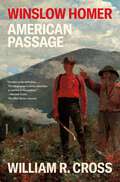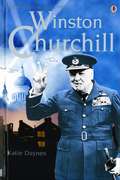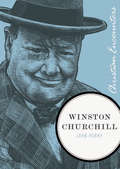- Table View
- List View
Winnie Lightner: Tomboy of the Talkies (Hollywood Legends Series)
by David L. LightnerWinnie Lightner (1899–1971) stood out as the first great female comedian of the talkies. Blessed with a superb singing voice and a gift for making wisecracks and rubber faces, she rose to stardom in vaudeville and on Broadway. Then, at the dawn of the sound era, she became the first person in motion picture history to have her spoken words, the lyrics to a song, censored. In Winnie Lightner: Tomboy of the Talkies, David L. Lightner shows how Winnie Lightner's hilarious performance in the 1929 musical comedy Gold Diggers of Broadway made her an overnight sensation. She went on to star in seven other Warner Bros. features. In the best of them, she was the comic epitome of a strident feminist, dominating men and gleefully spurning conventional gender norms and moral values. So tough was she, the studio billed her as “the tomboy of the talkies.” When the Great Depression rendered moviegoers hostile toward feminism, Warner Bros. tried to craft a new image of her as glamorous and sexy. Executives assigned her contradictory roles in which she was empowered in the workplace but submissive to her male partner at home. The new persona flopped at the box office, and Lightner's stardom ended. In four final movies, she played supporting roles as the loudmouthed roommate and best friend of actresses Loretta Young, Joan Crawford, and Mona Barrie. Following her retirement in 1934, Lightner faded into obscurity. Many of her films were damaged or even lost entirely. At long last, this biography gives Winnie Lightner the recognition she deserves as a notable figure in film history, in women's history, and in the history of show business.
Winnie Mandela: A Life
by Anne Marie du Preez BezdrobEveryone has an opinion about Winnie Mandela, and usually a strong one. She has been adored, feared and hated more than any other woman in South African history. But few people know much about the life behind the headlines, myths and sound-bites. This biography is an in-depth and intimate look at Winnie Mandela's personal and political life, and takes the reader on a remarkable journey of understanding. <p><p>The book traces her development from talented and privileged child to dedicated social worker, caring wife and mother, and fiery political activist. It examines her vigorous campaign to keep the name of her jailed husband alive, and explores her own harassment, imprisonment and isolation at the hands of the security police. Finally, the book investigates the events that have made Winnie Mandela such a controversial figure: the allegations of kidnapping and murder, her divorce from Mandela, and the current fraud charges. Winnie Mandela's journey to this point is traced with understanding and honesty, in this fascinating and balanced biography of a most enigmatic woman.
Winnie and Nelson: Portrait of a Marriage
by Jonny SteinbergFrom one of South Africa&’s foremost nonfiction writers, a deeply researched, shattering new account of Nelson Mandela&’s relationship with Winnie Madikizela-Mandela. Drawing on never-before-seen material, Steinberg reveals the fractures and stubborn bonds at the heart of a volatile and groundbreaking union, a very modern political marriage that played out on the world stage.One of the most celebrated political leaders of a century, Nelson Mandela has been written about by many biographers and historians. But in one crucial area, his life remains largely untold: his marriage to Winnie Madikizela-Mandela. During his years in prison, Nelson grew ever more in love with an idealized version of his wife, courting her in his letters as if they were young lovers frozen in time. But Winnie, every bit his political equal, found herself increasingly estranged from her jailed husband&’s politics. Behind his back, she was trying to orchestrate an armed seizure of power, a path he feared would lead to an endless civil war.Jonny Steinberg tells the tale of this unique marriage—its longings, its obsessions, its deceits—making South African history a page-turning political biography. Winnie and Nelson is a modern epic in which trauma doesn&’t affect just the couple at its center, but an entire nation. It is also a Shakespearean drama in which bonds of love and commitment mingle with timeless questions of revolution, such as whether to seek retribution or a negotiated peace. Steinberg reveals, with power and tender emotional insight, how far these forever-entwined leaders would go for each other and where they drew the line. For in the end, both knew theirs was not simply a marriage, but a contest to decide how apartheid should be fought.
Winning Balance: What I've Learned So Far about Love, Faith, and Living Your Dreams
by Nancy French Shawn JohnsonAmerican gymnast Johnson is a four-time Olympic gold and silver medalist; a national- and world-champion athlete and a winner on the popular "Dancing with the Stars." This is the amazing true journey of how this young Olympian has found balance in her life.
Winning Is Not Enough
by Jackie StewartSir Jackie Stewart is one of the most highly regarded names in global sport - winner of three F1 World Championships, 27 Grands Prix and ranked in the top five drivers of all time. On retiring from the circuit, he went on to build an equally impressive international business career. In the 1960s and into the 70s, with his black cap, sideburns and aviator shades Jackie Stewart was an unmistakable icon in a glorious era of style, glamour and speed. On the track, his story is one of drama, excitement, tragedy, controversy, celebrity, danger and massive success. Beyond the sport his life is a compelling tale of battling against the odds and achieving world-wide recognition as an outstanding sportsman, a role model and a highly accomplished and respected businessman.
Winning Is Not Enough
by Sir Jackie StewartSir Jackie Stewart is one of the most highly regarded names in global sport - winner of three F1 World Championships, 27 Grands Prix and ranked in the top five drivers of all time. On retiring from the circuit, he went on to build an equally impressive international business career. In the 1960s and into the 70s, with his black cap, sideburns and aviator shades Jackie Stewart was an unmistakable icon in a glorious era of style, glamour and speed. On the track, his story is one of drama, excitement, tragedy, controversy, celebrity, danger and massive success. Beyond the sport his life is a compelling tale of battling against the odds and achieving world-wide recognition as an outstanding sportsman, a role model and a highly accomplished and respected businessman.
Winning Isn't Everything: A Biography of Sir Alf Ramsey
by Dave BowlerA biography of world cup winning football manager Sir Alf RamseyEngland has never had a more successful national coach than Sir Alf Ramsey. A cultured full-back with Tottenham's push and run stylists, he turned to management once his international career had been cut short by Puskas' rampant Hungarians. At Ipswich Town he piloted a collection of comparative journeymen from the depths of the Third Division South to the heights of the League Championship, acquiring the job of England manager along the way.Fêted for winning the 1966 World Cup, castigated for the way he won it with his 'wingless wonders', then reviled for going out of the 1974 competition, Ramsey's achievements are lost in the legends of Russian linesmen, Bogotá and a Polish clown. Yet he was a commanding general, a footballing intellect beyond compare and a man who deserves more than caricature.Thoughtful and incisive, Dave Bowler's biography features extensive interviews with Geoff Hurst, Walter Winterbottom, Mick Channon, Tom Finney, Ray Wilson and Jimmy Armfield, among others, and reassesses Ramsey's contribution to the English game.
Winning Isn't Everything: A Biography of Sir Alf Ramsey
by Dave BowlerEngland has never had a more successful national coach than Sir Alf Ramsey. A cultured full-back with Tottenham's push and run stylists, he turned to management once his international career had been cut short by Puskas' rampant Hungarians. At Ipswich Town he piloted a collection of comparative journeymen from the depths of the Third Division South to the heights of the League Championship, acquiring the job of England manager along the way. F?ted for winning the 1966 World Cup, castigated for the way he won it with his 'wingless wonders;, then reviled for going out of the 1974 competition, Ramsey's achievements are lost in the legends of Russian linesmen, Bogot? and a Polish clown. Yet he was a commanding general, a footballing intellect beyond compare and a man who deserves more than caricature. Thoughtful and incisive, Dave Bowler's biography features extensive interviews with Geoff Hurst, Walter Winterbottom, Mick Channon, Tom Finney, Ray Wilson and Jimmy Armfield, among others, and reassesses Ramsey's contribution to the English game.
Winning Ugly
by Steve Jamison Brad GilbertHe's been called the best in the world at the mental game of tennis. Brad Gilbert's strokes may not be pretty, but looks aren't everything. He has beaten the Tour's biggest names -- all by playing his "ugly" game.Now, in Winning Ugly Gilbert teaches recreational players how to win more often without necessarily even changing their strokes. The key to success, he says, is to become a better thinking player -- to recognize, analyze, and capitalize. That means outthinking opponents before, during, and after a match; forcing him or her to play your game. Gilbert's unconventional advice includes:* How to identify the seven "Hidden Ad Points," and what to do when they come up* Six reasons why you should never serve first* How to beat a Lefty, a Retriever, a Serve-Volley player, and other troublesome opponents* How to keep a lead, or stop a match from slipping away* How to handle psyching and gamesmanshipWinning Ugly is an invaluable combat manual for the court, and its tips include "some real gems," according to Tennis magazine. Ultimately, Winning Ugly will help you beat players who have been beating you.
Winning Ways for Early Childhood Professionals: Being a Professional
by Gigi SchweikertWinning Ways for Early Childhood Professionals: Being a Professional is divided into six key steps that lay the framework for professionalism in the field. Whether tomorrow is your first day on the job or you’ve been teaching for twenty years, this book can provide a little help. Check out the 6 sections mentioned below and look for ways that you and others in your program can be more professional. 1 Look the Part; 2 Act the Part; 3 Know Your Stuff; 4 Be on the Job; 5 Save the Comments; and 6 Take Care.
Winning in Both Leagues: Reflections from Baseball's Front Office
by Billy Beane J. Frank CashenIn Winning in Both Leagues J. Frank Cashen looks back over his twenty-five-year career in baseball. Best known as the general manager of the New York Mets during their remaking and rise to glory in the 1980s, Cashen fills the pages with lively stories from his baseball tenure during the last half of the twentieth century. His career included a stint with the Baltimore Orioles of the late ’60s and ’70s, working with manager Earl Weaver and the great teams of the early ’70s, including such players as Jim Palmer, Frank Robinson, and Brooks Robinson. Later, tapped by Mets owner Nelson Doubleday Jr. to bring the Mets to the pinnacle of Major League Baseball, Cashen, with the rise of superstars Darryl Strawberry and Dwight Gooden, led the Mets to the thrilling come-from-behind victory over the Boston Red Sox leading to the World Series championship in 1986. Winning in Both Leagues also chronicles the drafting of Billy Beane, who would later be the focus of the New York Times bestseller Moneyball. Cashen, who was a central figure in the fierce competition with New York Yankees owner George Steinbrenner, excelled at building winning ball clubs and remains one of only two general managers ever to win a World Series in both leagues.
Winning in Reverse: Defying the Odds and Achieving Dreams—The Bill Lester Story
by Bill LesterThe amazing and dramatic story of Bill Lester, one of the most well-known NASCAR drivers in history—and a pioneer whose determination and spirit has paved the way for a new generation of racers.NASCAR has traditionally been a southern, white man&’s sports, but it was knocked off its axis when Bill Lester entered the playing field. Bill did not grow up in the sport as so many other drivers had. He enjoyed racing as a side hobby while he worked as an engineer at Hewlett-Packard until, at the age of 40, and while standing on the brink of peril or promise, he quit his job to pursue racing full time. Blessed with natural talent, Bill still had a trifecta of odds against him: he was black, he was middle aged, and he wasn&’t a southerner. Bill was not the quintessential &“good old boy&” that NASCAR was used to seeing and many fans did not hide their contempt for him. Bill Lester rose above it all, as did his rankings, and he made history time and time again, becoming the first African American to race in NASCAR&’s Busch Series, the first to participate in the Nextel Cup and the first to win a Pole Positon start in the NASCAR Craftsman Truck Series. In Winning In Reverse, Bill reveals how he came to love working on muscle cars as a child, racing in the streets as a teenager, getting married, pursuing amateur racing and then finally transitioning to the pros. Readers will be inspired by Bill's inspirational and encouraging voice and the conviction that fills each page. Whether you are contemplating a career or lifestyle change, challenging social norms, or struggling against prejudice or bigotry, Winning in Reverse is a story for sports fans and readers everywhere about the power of perserverance in the face of adversity.
Winning the Games Scientists Play
by Carl J. SindermannIn this inspiring book of personal insight and sound advice, veteran scientist Carl J. Sindermann gives an insider's look at the competitive world of science and reveals the best strategies for attaining prominence and success.
Winning the War on Cancer: The Epic Journey Towards a Natural Cure
by Sylvie Beljanski&“A fascinating combination of personal story and details on the suppression of holistic cancer(and other disease) therapies&” (Ann E. Fonfa, president, The Annie Appleseed Project). President Nixon signed the National Cancer Act in 1971, declaring a war on the disease. Nearly fifty years and several billion dollars later, it looks like we have lost the battle. Or have we? What if a natural solution had been there all along, just overlooked by the pharmaceutical industry? When a new, natural, and non-toxic way to address cancer is being discovered, it is a game changer that does not go unnoticed in the scientific community. But instead of being hailed and embraced, it is fiercely opposed by prominent scientists with strong ties to the pharmaceutical industry, and the might of the government is called to the rescue. As a result, we are losing the war on cancer. Mirko Beljanski, PhD, one of the first green molecular biologists, was called upon by former French president François Mitterrand to treat his prostate cancer, allowing him to reach his second term in office, but upon his death, Beljanski became the subject of relentless persecution aimed at wiping out this information. In Winning the War on Cancer, his daughter Sylvie Beljanski outlines her journey of learning about her father&’s discoveries, and ensuring his legacy is available to all those struggling with the disease today. &“Whether a current patient or caregiver, a survivor, a researcher, an author/speaker, or a physician, the information in this book is groundbreaking, exciting, and essential to know . . . Sincere, captivating, poignant, and educational.&” —Annie Brandt, founder and president of Emerita, Best Answer for Cancer Foundation
Winning the West With Words: Language and Conquest in the Lower Great Lakes
by James Joseph BussIndian Removal was a process both physical and symbolic, accomplished not only at gunpoint but also through language. In the Midwest, white settlers came to speak and write of Indians in the past tense, even though they were still present. Winning the West with Words explores the ways nineteenth-century Anglo-Americans used language, rhetoric, and narrative to claim cultural ownership of the region that comprises present-day Ohio, Indiana, and Illinois. Historian James Joseph Buss borrows from literary studies, geography, and anthropology to examine images of stalwart pioneers and vanished Indians used by American settlers in portraying an empty landscape in which they established farms, towns, and "civilized" governments. He demonstrates how this now-familiar narrative came to replace a more complicated history of cooperation, adaptation, and violence between peoples of different cultures. <p><p>Buss scrutinizes a wide range of sources--travel journals, captivity narratives, treaty council ceremonies, settler petitions, artistic representations, newspaper editorials, late-nineteenth-century county histories, and public celebrations such as regional fairs and centennial pageants and parades--to show how white Americans used language, metaphor, and imagery to accomplish the symbolic removal of Native peoples from the region south of the Great Lakes. Ultimately, he concludes that the popular image of the white yeoman pioneer was employed to support powerful narratives about westward expansion, American democracy, and unlimited national progress. Buss probes beneath this narrative of conquest to show the ways Indians, far from being passive, participated in shaping historical memory--and often used Anglo-Americans' own words to subvert removal attempts. <p><p>By grounding his study in place rather than focusing on a single group of people, Buss goes beyond the conventional uses of history, giving readers a new understanding not just of the history of the Midwest but of the power of creation narratives.
Winning with Diabetes: Inspiring Stories from Athletes to Help You Thrive (A Johns Hopkins Press Health Book)
by Patrick J. Smith Rita R. Kalyani Mark D. CorriereDon't let diabetes send you to the bench. These motivational stories of top athletes with diabetes will inspire you to live your best life.An ultra-marathoner, a three-time Olympic gold medalist, a major league pitcher, and an NFL star. What do these elite athletes have in common? They reached the top of their field—all while living with diabetes. Essential reading for people who have diabetes and their families, Winning with Diabetes highlights the challenges, perseverance, and successes of sixteen elite athletes living with the disease. From mountain climber Will Cross, to college softball champion Kylee Perez, to NBA legend Dominique Wilkins, and many more, these are the real-life stories of diagnosis, adapting new day-to-day routines, finding support, training, competing, and connecting with communities of other people living with diabetes. The book features advice for facing common fears and challenges, both on and off the playing field. Each chapter includes interviews with athletes about their experiences, paired with expert commentary from the authors. Chapters also include summaries of key concepts, along with illustrations and other graphics.Winning with Diabetes will inspire readers of all ages—those newly diagnosed as well as those who have lived with diabetes for years. Written by physicians who have set the standards for management of the disease, this book brings you expert insight into finding ways to live your best life. Let the experts, the athletes, and the inspiration in Winning with Diabetes give you what you need to you stay in the game.
Winning!: The path to Rugby World Cup glory
by Clive Woodward'There is so much more to the man than single-minded determination.' Sunday Telegraph 'His first day in the job of England coach is superbly described, and thereafter he is forever going the extra yard to make his team great.' Sunday Times__________Winning! tells a remarkable story - an unforgettable journey that began in September 1997 and took the English Rugby Team team from the lower ranks of international first-class rugby to the top as World Cup Champions. Sir Clive Woodward and his team mounted a campaign of vast change, great learning, team building and clear vision to achieve their aim. 'We would question everything, change anything and leave no stone unturned,' he writes. WINNING! will talk about the team's journey of innovation and discovery and will reveal exactly how it happened, the fundamentals of their success and how these principles can be applied to any human endeavour. 'We changed the way we coached, the way we played and, of equal importance, how we operated off the field.' Bringing his business management skills to the game, Woodward simplified the entire approach to the structure of the team and created new management systems both on and off the pitch.In an anecdotal style, Clive Woodward entertains and informs while he describes the thrilling build-up to England's World Cup triumph in 2003.
Winning!: The path to Rugby World Cup glory
by Clive Woodward'There is so much more to the man than single-minded determination.' Sunday Telegraph 'His first day in the job of England coach is superbly described, and thereafter he is forever going the extra yard to make his team great.' Sunday Times__________Winning! tells a remarkable story - an unforgettable journey that began in September 1997 and took the English Rugby Team team from the lower ranks of international first-class rugby to the top as World Cup Champions. Sir Clive Woodward and his team mounted a campaign of vast change, great learning, team building and clear vision to achieve their aim. 'We would question everything, change anything and leave no stone unturned,' he writes. WINNING! will talk about the team's journey of innovation and discovery and will reveal exactly how it happened, the fundamentals of their success and how these principles can be applied to any human endeavour. 'We changed the way we coached, the way we played and, of equal importance, how we operated off the field.' Bringing his business management skills to the game, Woodward simplified the entire approach to the structure of the team and created new management systems both on and off the pitch.In an anecdotal style, Clive Woodward entertains and informs while he describes the thrilling build-up to England's World Cup triumph in 2003.
Winning's Only Part of the Game: Lessons of Life and Football
by Bobby Bowden Terry Bowden Ben BrownThe Bowden family talks about their lives and the pressures of being the "first family" of college football.
Winning: From Walk-On to Captain, in Football and Life
by Tony Dungy Gary BrackettFramed within the frenzy leading up to a Super Bowl, Gary Brackett flashes back to the defining moments and lessons in his journey leading to the threshold of a championship season. With his heart metaphorically on his jersey sleeve, Gary invites the reader inside the world of NFL football and the drama leading up to the biggest game day of the year. Along the way, Gary provides glimpses of real-life heroes, on and off the field, as he recounts the stories in this touching testament to the memory of his mom, dad and brother.
Wins, Losses and Lessons: An Autobiography
by Lou HoltzAutobiography of the only football coach to lead 6 different schools to bowl games, and the 9th winningest coach in college football history.
Wins, Losses, and Lessons: An Autobiography
by Lou HoltzWhen I die and people realize that I will not be resurrected in three days, they will forget me. That is the way it should be. For reasons known only to God, I was asked to write an autobiography. Most people who knew me growing up didn't think I would ever read a book, let alone write one.—Lou HoltzFew people in the history of college sports have been more influential or had a bigger impact than Lou Holtz. Winner of the three national Coach of the Year honors, the only coach ever to lead six different schools to season-ending bowl games, and the ninth-winningest coach in college football history, Holtz is still teaching and coaching, although he is no longer on the gridiron. In his most telling work to date, the man still known as "Coach" by all who cross his path reveals what motivated a rail-thin 135-pound kid with marginal academic credentials and a pronounced speech impediment to play and coach college football, and to become one of the most sought-after motivational speakers in history. With unflinching honesty and his trademark dry wit, Holtz goes deep, giving us the intimate details of the people who shaped his life and the decisions he would make that shaped the lives of so many others.His is a storied career, and Holtz provides a frank and inside look at the challenges he overcame to turn around the programs at William and Mary, North Carolina State, Arkansas, and Minnesota. From growing up in East Liverpool, Ohio, to his early days as a graduate assistant at the University of Iowa, to his national championship runs at Notre Dame and his final seasons on the sidelines in South Carolina, Lou Holtz gives his best, a poignant, funny, and instructive look into a life well lived.
Winslow Homer: American Passage
by William R. CrossThe definitive life of the painter who forged American identity visually, in art and illustration, with an impact comparable to that of Walt Whitman and Mark Twain in poetry and prose—yet whose own story has remained largely untold.In 1860, at the age of twenty-four, Winslow Homer (1836–1910) sold Harper’s Weekly two dozen wood engravings, carved into boxwood blocks and transferred to metal plates to stamp on paper. One was a scene that Homer saw on a visit to Boston, his hometown. His illustration shows a crowd of abolitionists on the brink of eviction from a church; at their front is Frederick Douglass, declaring “the freedom of all mankind.” Homer, born into the Panic of 1837 and raised in the years before the Civil War, came of age in a nation in crisis. He created multivalent visual tales, both quintessentially American and quietly replete with narrative for and about people of all races and ages. Whether using pencil, watercolor, or, most famously, oil, Homer addressed the hopes and fears of his fellow Americans and invited his viewers into stories embedded with universal, timeless questions of purpose and meaning. Like his contemporaries Twain and Whitman, Homer captured the landscape of a rapidly changing country with an artist’s probing insight. His tale is one of America in all its complexity and contradiction, as he evolved and adapted to the restless spirit of invention transforming his world. In Winslow Homer: American Passage, William R. Cross reveals the man behind the art. It is the surprising story of a life led on the front lines of history. In that life, this Everyman made archetypal images of American culture, endowed with a force of moral urgency through which they speak to all people today.Includes Color Images and Maps
Winston Churchill
by Jane Chisholm Katie DaynesUsborne Famous lives retell the story of Winston Churchill who had his finest hour when he led his country in the fight against Nazi Germany.
Winston Churchill
by John PerryChristian Encounters, a series of biographies from Thomas Nelson Publishers, highlights important lives from all ages and areas of the Church. Some are familiar faces. Others are unexpected guests. But all, through their relationships, struggles, prayers, and desires, uniquely illuminate our shared experience. Winston Churchill captivated the world with his voice and his writings. His books and speeches ooze with patriotism and faith in a just God. But he wasn't always known for his oratory skills, his faith, or his ability to captivate. In fact, as a child, he was small for his age, accident-prone, and frequently sick. To make matters worse, he was stubborn and self-centered, had a lisp, and did poorly in school. Born to an aristocratic family, young Winston was whisked off to boarding school at an early age, ignored by his parents, and left in the care of a nanny, Elizabeth Everest. But Everest excelled where Winston's own parents had failed him. She nurtured and encouraged him, and shared with him her own steadfast faith in God, shaping the views and vision of the persistent little English boy who would become one of the most influential men in history.
